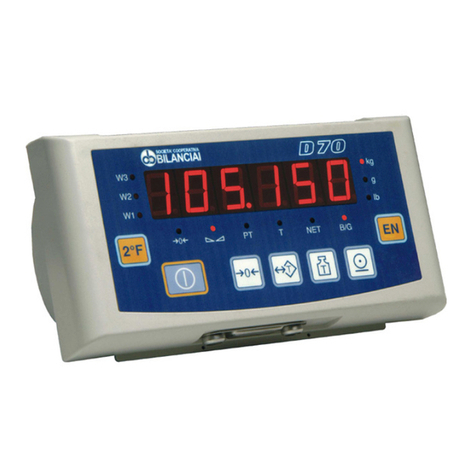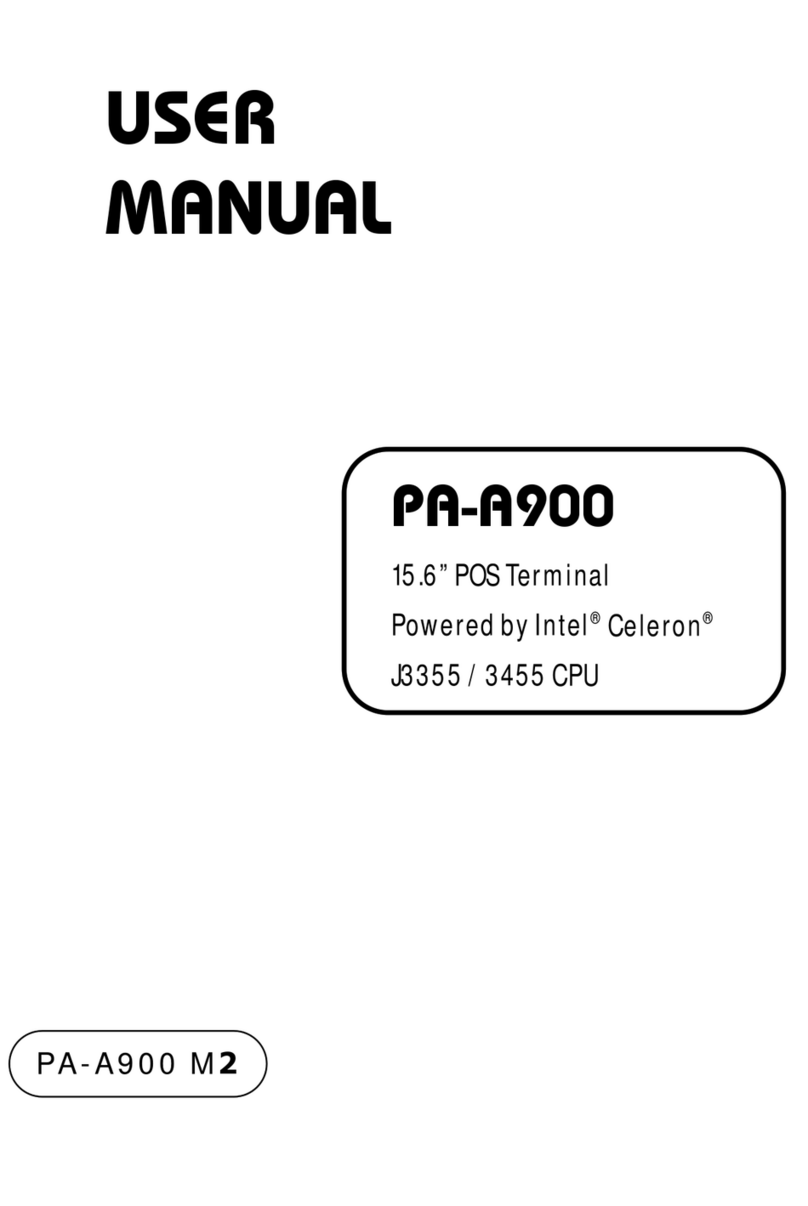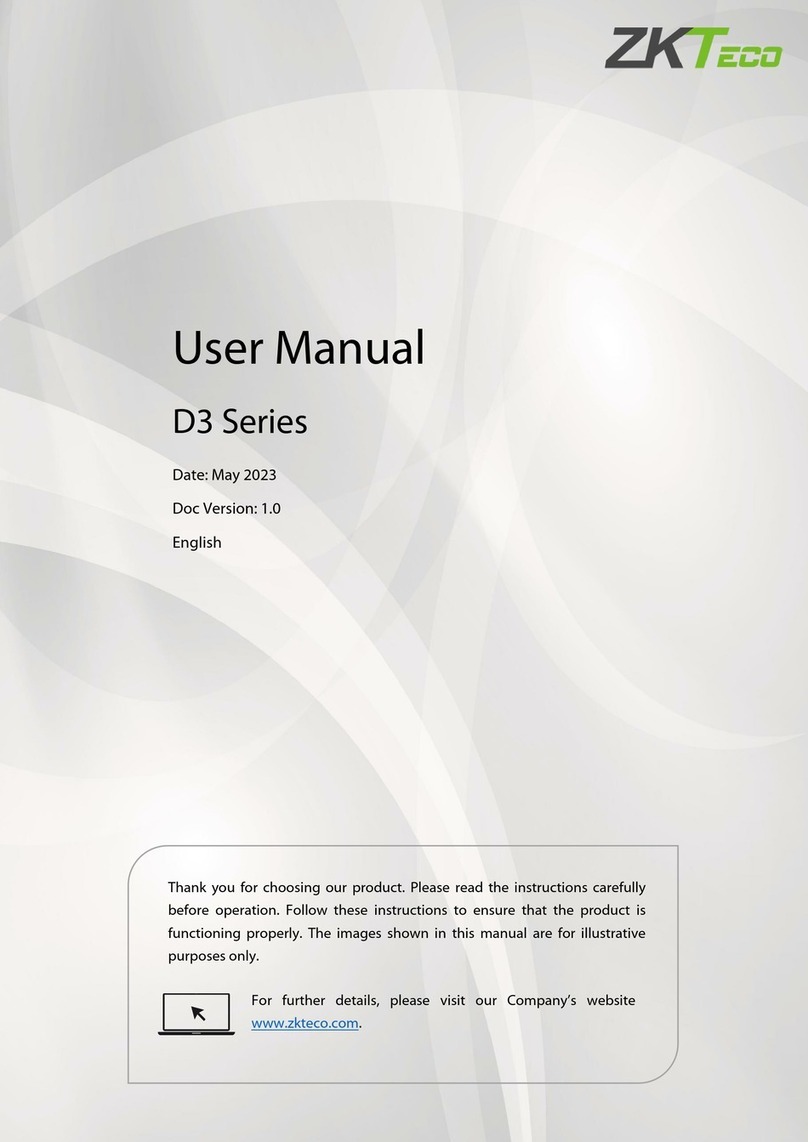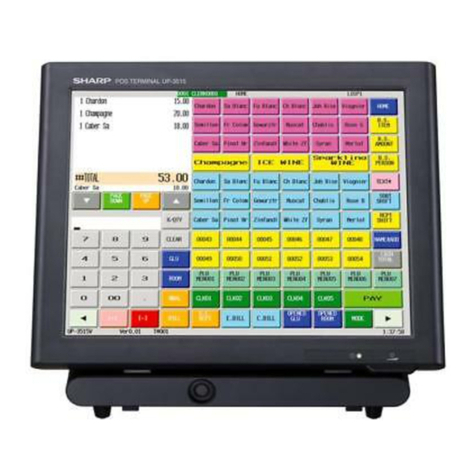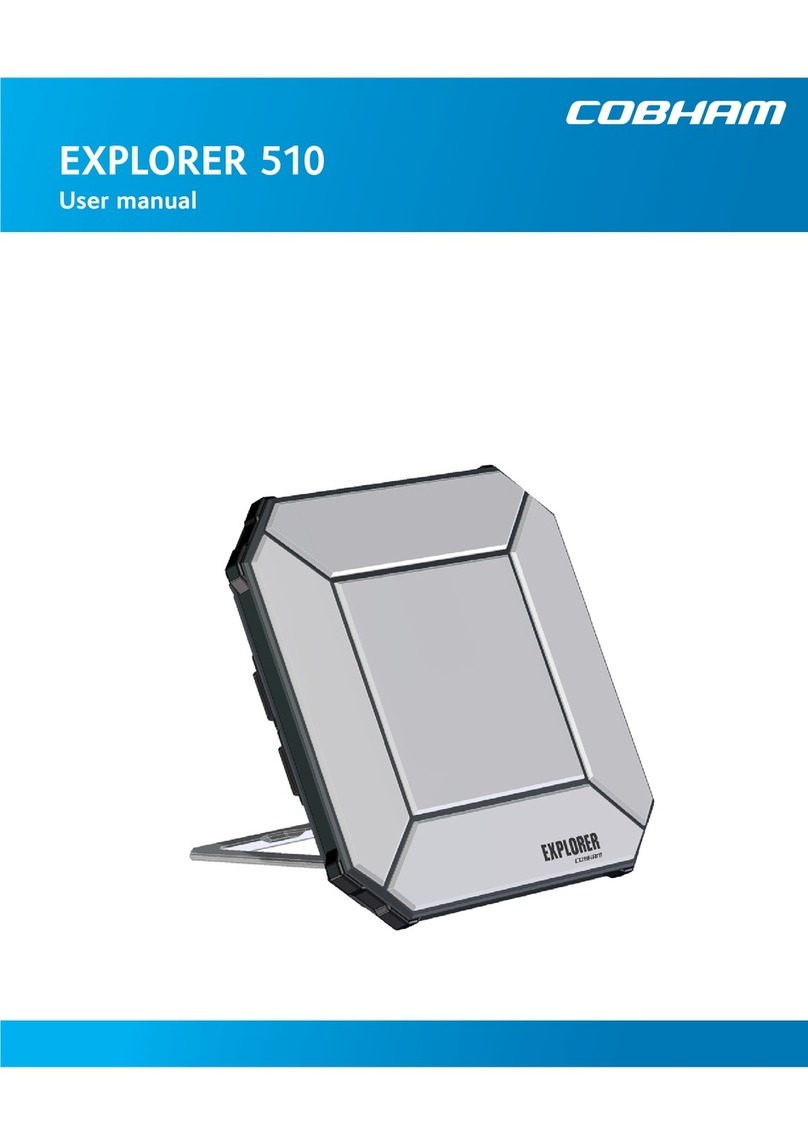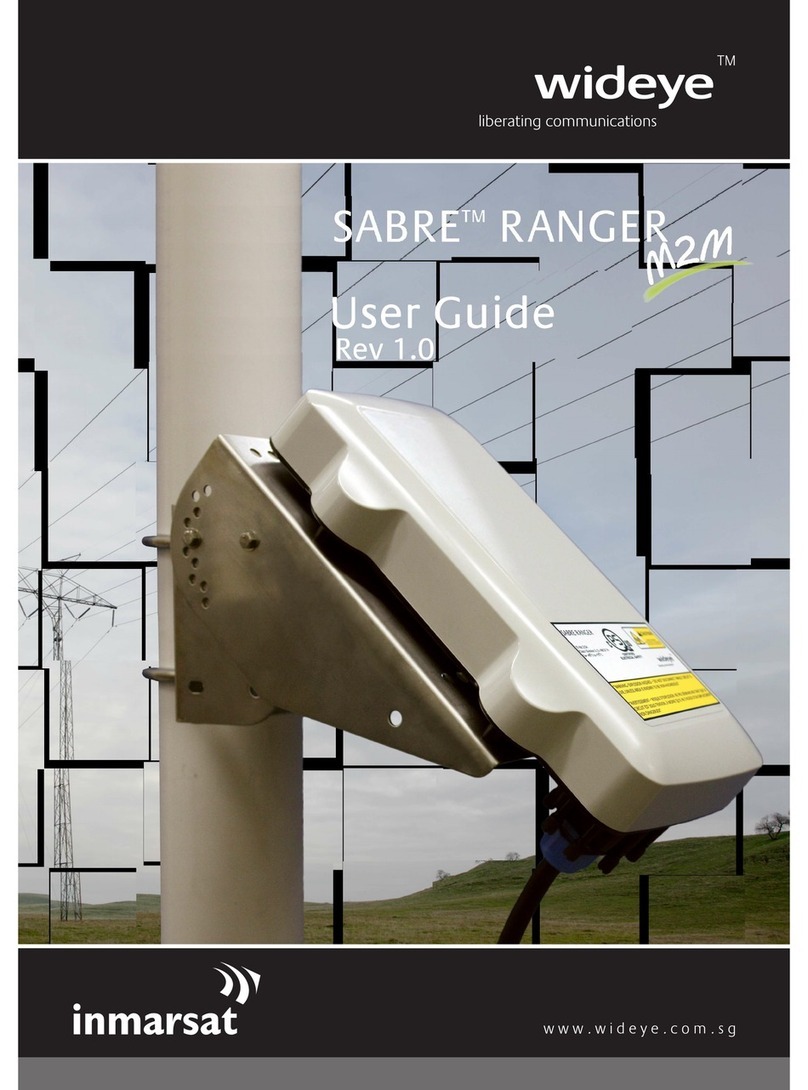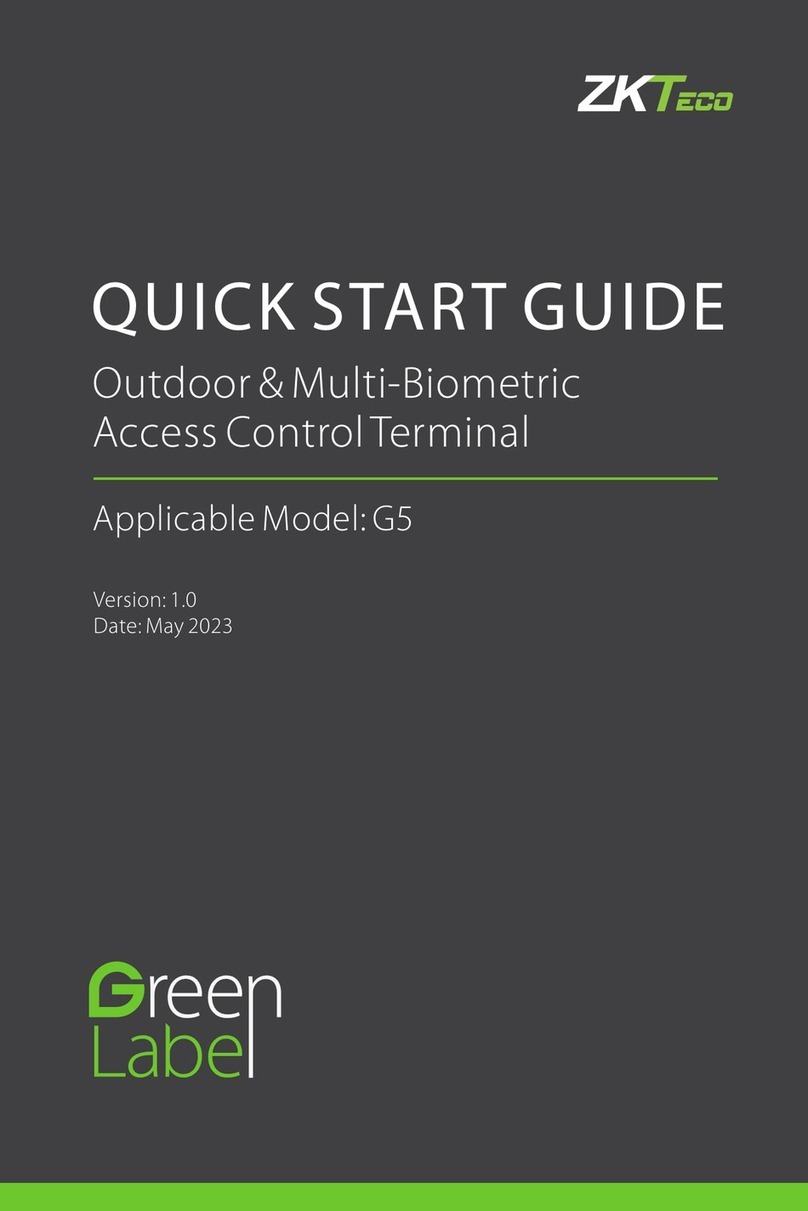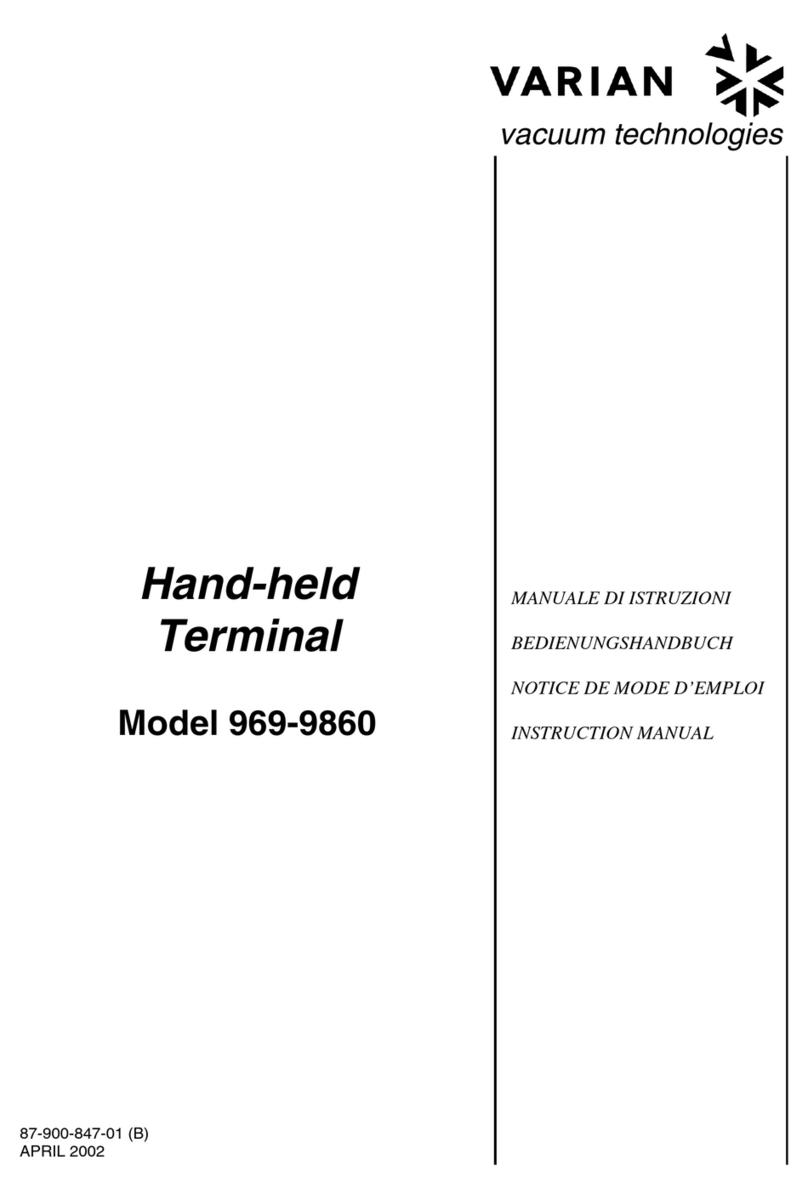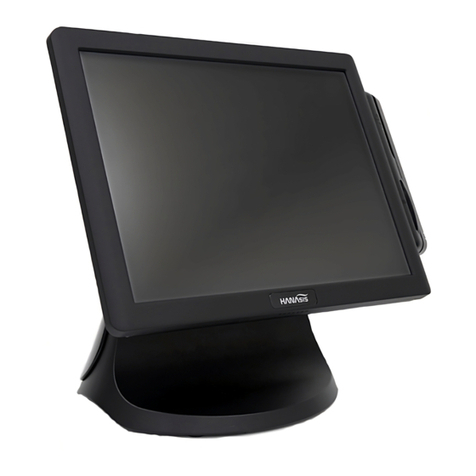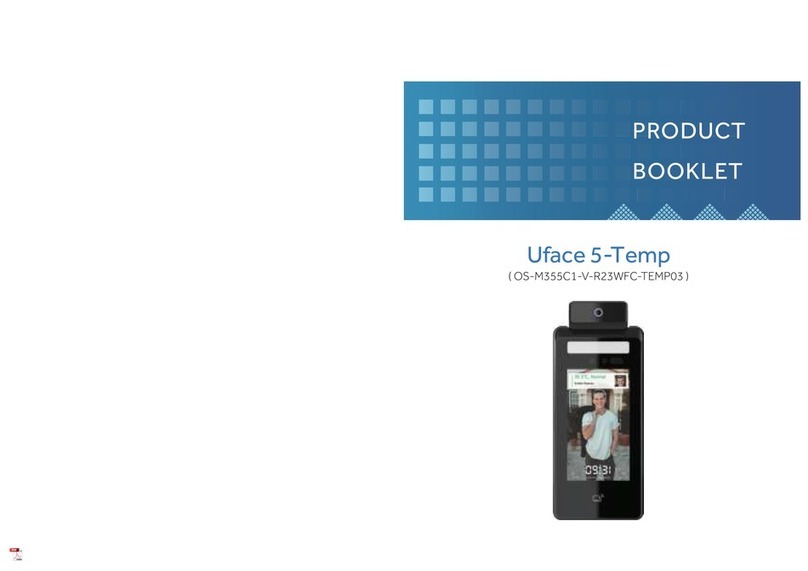B&R Mobile Panel 7200 User manual

Mobile Panel 7200
User's manual
Version: 1.01 (April 2020)
Order no.: MAMP7200-ENG
Translation of the original documentation
All values in this manual are current as of its creation. We reserve the right to change the contents of this manual
without notice. B&R Industrial Automation GmbH is not liable for technical or editorial errors and defects in this
manual. In addition, B&R Industrial Automation GmbH assumes no liability for damages that are directly or indirectly
attributable to the delivery, performance or use of this material. We point out that the software and hardware
designations and brand names of the respective companies used in this document are subject to general trademark,
brand or patent protection.

Table of contents
2 Mobile Panel 7200 User's manual V 1.01
1 General information.................................................................................................. 5
1.1 Manual history.................................................................................................................................................5
1.2 General safety guidelines............................................................................................................................... 6
1.2.1 Intended use..............................................................................................................................................6
1.2.2 Protection against electrostatic discharge.................................................................................................6
1.2.2.1 Packaging.............................................................................................................................................6
1.2.2.2 Regulations for proper ESD handling..................................................................................................6
1.2.3 Regulations and measures........................................................................................................................6
1.2.4 Transport and storage............................................................................................................................... 7
1.2.5 Installation..................................................................................................................................................7
1.2.6 Operation................................................................................................................................................... 7
1.2.6.1 Protection against contact with electrical parts................................................................................... 7
1.2.6.2 Ambient conditions - Dust, moisture, aggressive gases......................................................................7
1.2.6.3 Programs, viruses and malicious programs........................................................................................ 7
1.2.7 Cybersecurity disclaimer for products....................................................................................................... 8
1.3 Information about this document.................................................................................................................... 9
1.3.1 Organization of notices..............................................................................................................................9
1.3.2 Guidelines.................................................................................................................................................. 9
2 Technical data......................................................................................................... 10
2.1 Introduction....................................................................................................................................................10
2.1.1 Ergonomics.............................................................................................................................................. 10
2.1.2 Configuration............................................................................................................................................11
2.1.3 Overview.................................................................................................................................................. 12
2.2 Complete system.......................................................................................................................................... 13
2.2.1 Device interface overview....................................................................................................................... 13
2.2.1.1 +24 VDC power supply......................................................................................................................13
2.2.1.2 Ethernet interface...............................................................................................................................13
2.2.1.3 USB interface..................................................................................................................................... 14
2.2.2 Operating and display elements..............................................................................................................15
2.2.2.1 Touch screen......................................................................................................................................15
2.2.2.2 Mobile Panel 7251 - Membrane keypad........................................................................................... 15
2.2.2.3 Stop button.........................................................................................................................................17
2.2.2.4 Key switch.......................................................................................................................................... 17
2.2.2.5 Enabling control device......................................................................................................................18
2.2.3 Handle and hand strap............................................................................................................................22
2.3 Individual components.................................................................................................................................. 23
2.3.1 Control devices........................................................................................................................................23
2.3.1.1 5MP7251.101P-000............................................................................................................................23
2.3.2 Cables......................................................................................................................................................26
2.3.2.1 Attachment cables..............................................................................................................................26
2.3.2.2 Control cabinet cables....................................................................................................................... 29
3 Commissioning........................................................................................................37
3.1 Commissioning from a safety point of view..................................................................................................37
3.1.1 Proper use of the machine or system.....................................................................................................37
3.2 Attachment shaft........................................................................................................................................... 38
3.3 Cable installation...........................................................................................................................................38
3.3.1 Notes about compliance with the degree of protection...........................................................................39
3.4 Installing cables in the attachment shaft...................................................................................................... 40
3.4.1 Notes about compliance with the degree of protection...........................................................................40
3.5 Installing the handle and hand strap............................................................................................................ 41
3.6 Operating the Mobile Panel.......................................................................................................................... 43
3.6.1 Touch screen calibration..........................................................................................................................43
3.6.1.1 Windows 10 IoT Enterprise 2016 LTSB............................................................................................ 43
3.7 Key and LED configuration...........................................................................................................................44
3.8 Using the USB interface............................................................................................................................... 45

Table of contents
Mobile Panel 7200 User's manual V 1.01 3
3.9 User tips for increasing the service life of the display..................................................................................46
3.9.1 Backlight.................................................................................................................................................. 46
3.9.1.1 Measures to maintain backlight service life.......................................................................................46
3.9.2 Image persistence................................................................................................................................... 46
3.9.2.1 What causes image persistence?......................................................................................................46
3.9.2.2 How can image persistence be reduced?......................................................................................... 46
3.10 Pixel errors.................................................................................................................................................. 46
4 Software................................................................................................................... 47
4.1 BIOS options................................................................................................................................................. 47
4.1.1 General information................................................................................................................................. 47
4.1.2 BIOS Setup and start procedure.............................................................................................................47
4.1.3 Keys for BIOS Setup and boot menu..................................................................................................... 47
4.2 Operating systems........................................................................................................................................ 48
4.2.1 5SWW10.0561-MUL................................................................................................................................ 48
4.2.1.1 General information............................................................................................................................48
4.2.1.2 Order data.......................................................................................................................................... 48
4.2.1.3 Overview.............................................................................................................................................48
4.2.1.4 Features............................................................................................................................................. 48
4.2.1.5 Installation.......................................................................................................................................... 48
4.2.1.6 Activation............................................................................................................................................ 48
4.2.1.7 Characteristics, limitations................................................................................................................. 49
4.2.1.8 Supported display resolutions............................................................................................................50
4.3 Automation Device Interface (ADI)............................................................................................................... 50
4.3.1 ADI driver.................................................................................................................................................51
4.3.1.1 Installation.......................................................................................................................................... 51
4.3.1.2 Control Center....................................................................................................................................51
4.3.1.3 Characteristics, limitations................................................................................................................. 51
4.3.2 ADI Development Kit............................................................................................................................... 52
4.3.3 ADI .NET SDK.........................................................................................................................................53
4.3.3.1 Characteristics, limitations................................................................................................................. 53
5 Configuration........................................................................................................... 54
5.1 Key configuration.......................................................................................................................................... 54
5.1.1 Editing the KCM file................................................................................................................................ 54
5.1.2 Key codes................................................................................................................................................55
6 International and national certifications...............................................................57
6.1 Standards...................................................................................................................................................... 57
7 Accessories............................................................................................................. 58
7.1 USB flash drives........................................................................................................................................... 58
7.1.1 5MMUSB.xxxx-01.................................................................................................................................... 58
7.1.1.1 General information............................................................................................................................58
7.1.1.2 Order data.......................................................................................................................................... 58
7.1.1.3 Technical data....................................................................................................................................58
7.1.1.4 Temperature/Humidity diagram..........................................................................................................60
7.1.2 5MMUSB.032G-02...................................................................................................................................61
7.1.2.1 General information............................................................................................................................61
7.1.2.2 Order data.......................................................................................................................................... 61
7.1.2.3 Technical data....................................................................................................................................61
7.1.2.4 Temperature/Humidity diagram..........................................................................................................62
7.2 Wall mounts...................................................................................................................................................63
7.2.1 5ACCWB70.0000-000............................................................................................................................. 63
7.2.1.1 General information............................................................................................................................63
7.2.1.2 Order data.......................................................................................................................................... 63
7.2.1.3 Technical data....................................................................................................................................63

Table of contents
4 Mobile Panel 7200 User's manual V 1.01
7.2.1.4 5ACCWB70.0000-000 - Dimensions................................................................................................. 64
7.3 Connection boxes......................................................................................................................................... 65
7.3.1 4MPCBX.0000-00.................................................................................................................................... 65
7.3.1.1 General information............................................................................................................................65
7.3.1.2 Order data.......................................................................................................................................... 65
7.3.1.3 Interfaces............................................................................................................................................65
7.3.1.4 Technical data....................................................................................................................................66
7.3.1.5 Safety characteristics......................................................................................................................... 67
7.3.1.6 Dimensions.........................................................................................................................................67
7.3.1.7 Drilling template 4MPCBX.0000-00................................................................................................... 67
7.3.1.8 Content of delivery.............................................................................................................................67
7.3.2 4MPCBX.0001-00.................................................................................................................................... 68
7.3.2.1 General information............................................................................................................................68
7.3.2.2 Order data.......................................................................................................................................... 68
7.3.2.3 Technical data....................................................................................................................................68
7.3.2.4 Dimensions.........................................................................................................................................69
7.3.2.5 Drilling template 4MPCBX.0000-01................................................................................................... 69
7.3.2.6 Content of delivery.............................................................................................................................69
7.4 Box cables.....................................................................................................................................................70
7.4.1 5CAMPB.0xxx-10.....................................................................................................................................70
7.4.1.1 General information............................................................................................................................70
7.4.1.2 Order data.......................................................................................................................................... 70
7.4.1.3 Technical data....................................................................................................................................71
7.4.1.4 Cable pinout....................................................................................................................................... 72
8 Maintenance.............................................................................................................73
8.1 Cleaning........................................................................................................................................................ 73
8.2 Repairs/Complaints and replacement parts..................................................................................................73
Appendix A Stop button............................................................................................74
Appendix B Enabling control device....................................................................... 75
Appendix C Chemical resistance............................................................................. 76
Appendix D Viewing angles...................................................................................... 77
13 Abbreviations.........................................................................................................78

General information
6 Mobile Panel 7200 User's manual V 1.01
1.2 General safety guidelines
1.2.1 Intended use
Programmable logic controllers, operating and monitoring devices (e.g. industrial PCs, Power Panels, Mobile Pan-
els) as well as uninterruptible power supplies from B&R have been designed, developed and manufactured for
normal use in industry. They have not been designed, developed and manufactured for use that involves fatal
risks or hazards that could result in death, injury, serious physical harm or other loss without the assurance of
exceptionally stringent safety precautions. In particular, this includes the use of these systems to monitor nuclear
reactions in nuclear power plants, flight control systems, air traffic control, the control of mass transport vehicles,
medical life support systems and the control of weapon systems.
1.2.2 Protection against electrostatic discharge
Electrical assemblies that can be damaged by electrostatic discharge (ESD) must be handled accordingly.
1.2.2.1 Packaging
•Electrical assemblies with housing:
Do not require special ESD packaging but must be handled properly (see "Electrical assemblies with hous-
ing").
•Electrical assemblies without housing:
Are protected by ESD-suitable packaging.
1.2.2.2 Regulations for proper ESD handling
Electrical assemblies with housing
•Do not touch the connector contacts of connected cables.
•Do not touch the contact tips on circuit boards.
Electrical assemblies without housing
The following applies in addition to "Electrical assemblies with housing":
•All persons handling electrical assemblies and devices in which electrical assemblies are installed must
be grounded.
•Assemblies are only permitted to be touched on the narrow sides or front plate.
•Always place assemblies on suitable surfaces (ESD packaging, conductive foam, etc.). Metallic surfaces
are not suitable surfaces!
•Assemblies must not be subjected to electrostatic discharges (e.g. due to charged plastics).
•A minimum distance of 10 cm from monitors or television sets must be maintained.
•Measuring instruments and devices must be grounded.
•Test probes of floating potential measuring instruments must be discharged briefly on suitable grounded
surfaces before measurement.
Individual components
•ESD protective measures for individual components are implemented throughout B&R (conductive floors,
shoes, wrist straps, etc.).
•The increased ESD protective measures for individual components are not required for handling B&R
products at customer locations.
1.2.3 Regulations and measures
Electronic devices are generally not failsafe. If the programmable logic controller, operating or control device or
uninterruptible power supply fails, the user is responsible for ensuring that connected devices (such as motors)
are brought to a safe state.
When using programmable logic controllers as well as when using operating and monitoring devices as control
systems in conjunction with a Soft PLC (e.g. B&R Automation Runtime or similar product) or Slot PLC (e.g. B&R
LS251 or similar product), the safety measures that apply to industrial controllers (protection by protective equip-
ment such as emergency stops) must be observed in accordance with applicable national and international regu-
lations. This also applies to all other connected devices, such as drives.

General information
Mobile Panel 7200 User's manual V 1.01 7
All work such as installation, commissioning and servicing are only permitted to be carried out by qualified person-
nel. Qualified personnel are persons who are familiar with the transport, installation, assembly, commissioning and
operation of the product and have the appropriate qualifications for their job (e.g. IEC 60364). National accident
prevention regulations must be observed.
The safety guidelines, information about connection conditions (nameplate and documentation) and limit values
specified in the technical data must be read carefully before installation and commissioning and must be strictly
observed.
1.2.4 Transport and storage
During transport and storage, devices must be protected against undue stress (mechanical stress, temperature,
humidity, aggressive atmosphere).
1.2.5 Installation
•The devices are not ready for use and must be installed and wired according to the requirements of this
documentation in order to comply with EMC limit values.
•Installation must be carried out according to the documentation using suitable equipment and tools.
•Devices are only permitted to be installed by qualified personnel when the power is switched off. The control
cabinet must first be disconnected from the power supply and secured against being switched on again.
•General safety regulations and national accident prevention regulations must be observed.
•The electrical installation must be carried out in accordance with relevant regulations (e.g. wire cross sec-
tion, fuse protection, protective ground connection).
1.2.6 Operation
1.2.6.1 Protection against contact with electrical parts
In order to operate programmable logic controllers, operating and monitoring devices and uninterruptible power
supplies, it is necessary for certain components to carry dangerous voltages over 42 VDC. Touching one of these
components can result in a life-threatening electric shock. There is a risk of death, serious injury or damage to
property.
Before switching on programmable logic controllers, operating and monitoring devices and uninterruptible power
supplies, it must be ensured that the housing is properly connected to ground potential (PE rail). The ground
connection must also be made if the operating and monitoring device and uninterruptible power supply are only
connected for testing purposes or only operated for a short time!
Before switching on, live parts must be securely covered. All covers must be kept closed during operation.
1.2.6.2 Ambient conditions - Dust, moisture, aggressive gases
The use of operating and monitoring devices (e.g. industrial PCs, Power Panels, Mobile Panels) and uninterruptible
power supplies in dusty environments must be avoided. This can otherwise result in dust deposits that affect the
functionality of the device, especially in systems with active cooling (fans), which may no longer ensure sufficient
cooling.
The presence of aggressive gases in the environment can also result in malfunctions. In combination with high
temperature and relative humidity, aggressive gases – for example with sulfur, nitrogen and chlorine components
– trigger chemical processes that can very quickly impair or damage electronic components. Blackened copper
surfaces and cable ends in existing installations are indicators of aggressive gases.
When operated in rooms with dust and condensation that can endanger functionality, operating and monitoring
devices such as Automation Panels or Power Panels are protected on the front against the ingress of dust and
moisture when installed correctly (e.g. cutout installation). The back of all devices must be protected against the
ingress of dust and moisture, however, or the dust deposits must be removed at suitable intervals.
1.2.6.3 Programs, viruses and malicious programs
Any data exchange or installation of software using data storage media (e.g. floppy disk, CD-ROM, USB flash
drive) or via networks or the Internet poses a potential threat to the system. It is the direct responsibility of the user
to avert these dangers and to take appropriate measures such as virus protection programs and firewalls to protect
against them and to use only software from trustworthy sources.

General information
8 Mobile Panel 7200 User's manual V 1.01
1.2.7 Cybersecurity disclaimer for products
B&R products communicate via a network interface and were developed for secure connection with internal and,
if necessary, other networks such as the Internet.
Information:
In the following, B&R products are referred to as "product" and all types of networks (e.g. internal
networks and the Internet) are referred to as "network".
It is the sole responsibility of the customer to establish and continuously ensure a secure connection between
the product and the network. In addition, appropriate security measures must be implemented and maintained
to protect the product and entire network from any security breaches, unauthorized access, interference, digital
intrusion, data leakage and/or theft of data or information.
B&R Industrial Automation GmbH and its subsidiaries are not liable for damages and/or losses in connection
with security breaches, unauthorized access, interference, digital intrusion, data leakage and/or theft of data or
information.
The aforementioned appropriate security measures include, for example:
•Segmentation of the network (e.g. separation of the IT network from the control network1))
•Use of firewalls
•Use of authentication mechanisms
•Encryption of data
•Use of anti-malware software
Before B&R releases products or updates, they are subjected to appropriate functional testing. Independently of
this, we recommend that our customers develop their own test processes in order to be able to check the effects
of changes in advance. Such changes include, for example:
•Installation of product updates
•Significant system modifications such as configuration changes
•Deployment of updates or patches for third-party software (non-B&R software)
•Hardware replacement
These tests should ensure that implemented security measures remain effective and that systems in the customer's
environment behave as expected.
1) The term "control network" refers to computer networks used to connect control systems. The control network can be divided into zones, and there can be
several separate control networks within a company or site. The term "control systems" refers to all types of B&R products such as controllers (e.g. X20), HMI
systems (e.g. Power Panel T30), process control systems (e.g. APROL) and supporting systems such as engineering workstations with Automation Studio.

General information
Mobile Panel 7200 User's manual V 1.01 9
1.3 Information about this document
This document is not intended for end customers! The safety guidelines required for end customers
must be incorporated into the operating instructions for end customers in the respective national lan-
guage by the machine manufacturer or system provider.
1.3.1 Organization of notices
Safety notices
Contain only information that warns of dangerous functions or situations.
Signal word Description
Danger! Failure to observe these safety guidelines and notices will result in death, severe injury or substantial damage to property.
Warning! Failure to observe these safety guidelines and notices can result in death, severe injury or substantial damage to property.
Caution! Failure to observe these safety guidelines and notices can result in minor injury or damage to property.
Notice! Failure to observe these safety guidelines and notices can result in damage to property.
General notices
Contain useful information for users and instructions for avoiding malfunctions.
Signal word Description
Information: Useful information, application tips and instructions for avoiding malfunctions.
1.3.2 Guidelines
European dimension standards apply to all dimension diagrams.
All dimensions in mm.
Unless otherwise specified, the following general tolerances apply:
Nominal dimension range General tolerance per
DIN ISO 2768 medium
Up to 6 mm ±0.1 mm
Over 6 to 30 mm ±0.2 mm
Over 30 to 120 mm ±0.3 mm
Over 120 to 400 mm ±0.5 mm
Over 400 to 1000 mm ±0.8 mm

Technical data
10 Mobile Panel 7200 User's manual V 1.01
2 Technical data
2.1 Introduction
The Mobile Panel is a portable operating and display device with a rugged
design. Equipped with powerful processors and Ethernet technology, the
Mobile Panel is optimally suited for a wide range of applications.
A color display ensures that all tasks can be managed visually, while the
touch screen ensures an intuitive user interface.
2.1.1 Ergonomics
•Functional multigrip
•Rounded housing
•Desktop operation
•Wall mount operation
•Easy-to-read display

Technical data
Mobile Panel 7200 User's manual V 1.01 11
2.1.2 Configuration
The following components are mandatory for a functional Mobile Panel 7200:
•Operator panel
•Attachment cables
MP7200 configuration
Operator panels
5MP7251.101P-000
Cables Select 1 each
Control cabinet cables
5CAMPC.0020-10 5CAMPC.0020-11
Attachment cables
5CAMPH.0018-40 5CAMPH.0050-40
5CAMPH.0100-40 5CAMPH.0150-40
5CAMPH.0200-40 -
Connection box Optional, select 1
4MPCBX.0000-000 4MPCBX.0001-000
Box cables Optional, select 11)
5CAMPB.0050-10 5CAMPB.0100-10
Wall mount Optional selection
5ACCWB70.0000-000
Accessories Optional selection
5MMUSB.2048-01
5MMUSB.4096-01
5MMUSB.032G-02
1) Only necessary if a connection box is selected.

Technical data
12 Mobile Panel 7200 User's manual V 1.01
2.1.3 Overview
Model number Short description Page
Attachment cables
5CAMPH.0018-40 Attachment cable for MP7100 and MP7200 - Push-Pull circular connector - 1.8 m 26
5CAMPH.0050-40 Attachment cable for MP7100 and MP7200 - Push-Pull circular connector - 5 m 26
5CAMPH.0100-40 Attachment cable for MP7100 and MP7200 - Push-Pull circular connector - 10 m 26
5CAMPH.0150-40 Attachment cable for MP7100 and MP7200 - Push-Pull circular connector - 15 m 26
5CAMPH.0200-40 Attachment cable for MP7100 and MP7200 - Push-Pull circular connector - 20 m 26
Control cabinet cables
5CAMPC.0020-10 Mobile Panel control cabinet cable - Push-Pull circular connector - Ethernet crossover - 2 m 29
5CAMPC.0020-11 Mobile Panel control cabinet cable - Push-Pull circular connector - Ethernet straight-through - 2 m 33
Operating units
5MP7251.101P-000 Mobile Panel 7200 10.1" WXGA TFT - 800 x 1280 pixels - Multi-touch (projected capacitive) - Intel Celeron
N2807 processor 2*1.58 GHz - 4 GB RAM - For Windows W10 2016 - 1x Ethernet 10/100, 1x USB 2.0 - 1x key
switch - 1x stop button - 1x enable switch - 21x system keys, 5x LEDs
23

Technical data
Mobile Panel 7200 User's manual V 1.01 13
2.2 Complete system
2.2.1 Device interface overview
Legend
1"Stop button" on page 17 2"Key switch" on page 17
3"Enabling control device" on page 18 4"USB interface" on page 14
2.2.1.1 +24 VDC power supply
The power supply is provided with an individually selected attachment cable (see "Attachment cables" on page
26) and control cabinet cable (see "Control cabinet cables" on page 29). Alternatively, a large connection
box (4MPCBX.0000-00) with associated box cable (see "Box cables" on page 70) can be used.
For the pinout, see the description of the corresponding cable type.
Danger!
•The device is only permitted to be supplied with a SELV/PELV power supply or with safety
extra-low voltage (SELV) per EN 60950.
•Safety extra-low voltage circuits must always be safely isolated from circuits with dangerous
voltage.
•In the end application, the 24 VDC power supply of the device must be adequately protected! A
fuse with max. 3.15 A and UL 248 certification must be used for this.
2.2.1.2 Ethernet interface
The Ethernet interface is located inside the device. The connection is made via the connector integrated in the
connection cable or control cabinet cable.
Ethernet interface (ETH)
Variant RJ45, female
Wiring Up to star-quad cables
Transfer rate 10/100 Mbit/s1)
Cable length Max. 20 m (min. Cat 5e)
Protocol TCP/IP
-
1) A transfer rate of 100 Mbit/s is only possible with a suitable attachment cable.
Switching takes place automatically.
Information:
Necessary drivers must be downloaded from the B&R website, not from manufacturer websites.

Technical data
14 Mobile Panel 7200 User's manual V 1.01
2.2.1.3 USB interface
MP7200 devices are equipped with an externally routed USB 2.0 interface with interface cover. This interface is
only to be used for service purposes; see "Using the USB interface" on page 45.
Caution!
IP65 protection can only be achieved if the USB protective cover is properly installed.
Warning!
USB peripheral devices can be connected to the USB interfaces. Due to the variety of USB devices
available on the market, B&R cannot guarantee their functionality. The functionality of USB devices
available from B&R is guaranteed.
Notice!
Because of general PC specifications, these USB interfaces should be handled with extreme care with
regard to EMC, cable routing, etc.
USB1
Standard USB 2.0
Variant Type A, female
Quantity 1
Low speed (1.5 Mbit/s)
Full speed (12 Mbit/s)
Transfer rate
High speed (480 Mbit/s)
Current-carrying capacity1) Max. 0.5 A
Cable length
USB 2.0 Max. 5 m
-
1) The USB interface is protected by a maintenance-free "USB current-limiting switch" (max. 0.5 A).

Technical data
Mobile Panel 7200 User's manual V 1.01 15
2.2.2 Operating and display elements
2.2.2.1 Touch screen
5MP7251.101P-000 uses a projected capacitive multi-touch screen.
The touch screen can be operated with one or more fingers (with or without gloves). The following operation
guidelines should be observed to ensure long life of the touch screen:
•The touch screen is not permitted to be operated with gloves or other suitable operating devices if they
have been contaminated with chemicals (see "Chemical resistance" on page 76) or hard, sharp-edged
substances (e.g. sand, grinding paste, metal cuttings of all kinds).
•The touch screen is not permitted to be operated with pointed, sharp metallic objects (e.g. screwdrivers)
or with ballpoint pens or pencils.
•The touch screen is not permitted to be exposed to continuous sunlight.
Caution!
Failure to observe these guidelines may significantly reduce the service life of the touch screen or
result in immediate damage or failure.
2.2.2.2 Mobile Panel 7251 - Membrane keypad
How keys/LEDs are assigned depends on how they will be used by the
customer.
Some keys are preconfigured at the factory. The key configuration can be
changed in a text file and transferred to the device using the ADI Control
Center (included in Windows, see "Keys and LEDs" on page 15).
The states of the keys or LEDs can be read or switched by a program using
the Automation Device Interface (ADI library).
Information:
This color printout is not a true color printout, i.e. the colors of
the panel overlay may vary slightly.
2.2.2.2.1 Keys and LEDs
Information:
The MP7251 does not support fast blinking; the ADI library handles fast blinking the same as slow
blinking.

Technical data
16 Mobile Panel 7200 User's manual V 1.01
Key Default value Key Default value
F1 F1 F2 F2
F3 F3 F4 F4
F5 F5 F6 F6
F7 F7 F8 F8
Keys
Symbol Possible use Factory key configuration
Application screen 1 Not preset
Customer settings Not preset
Project screen Not preset
Shortcut menu APPS
Positioning screen Not preset
Alarm screen Not preset
Start Left Windows key
Stop Not preset
Layer 2 LEFT SHIFT
Cancel ESC
Speed - Page down
Speed + Page up
LEDs
Description Cannot change usage
Power: The device is supplied.
Possible use Factory configuration
Run: Application in operation -
Run
Power
Error
Error: Error in application -
Feedback for startup -
2nd level enabled -

Technical data
Mobile Panel 7200 User's manual V 1.01 17
2.2.2.3 Stop button
The stop button has a dual-circuit design with normally closed contacts.
The gray stop button on the Mobile Panel satisfies the requirements of EN ISO 13850. It must be able to trigger
a category 0 or category 1 stop in accordance with the risk assessment of the machine (see EN 60204-1). The
wiring of the direct opening action switching contacts must satisfy the category (per EN ISO 13849-1) determined
during the machine's risk analysis (per EN ISO 12100:2010).
The gray stop button meets all mechanical requirements of EN ISO 13850 and differs only in the color of the
emergency stop switches.
Warning!
•Handheld control devices with a gray stop button that are not connected to a machine should
also be stored separately. This is to prevent confusion with functional equipment in emergen-
cies.
•Resetting the stop device is not permitted to result in an uncontrolled restart.
•The stop button is not a substitute for safety equipment.
•The stop button on the handheld control device is not a substitute for an emergency stop switch
directly on the machine.
•Certain mechanical faults in the stop button can only be detected when the button is actuated.
In the event of severe impact to the device (e.g. the device is dropped), the stop button must
be inspected to ensure functionality. In addition, stop functionality must be tested periodically
(every 6 months) by actuating the stop button.
•See section "International and national certifications" on page 57 for additional important
information about the stop button.
2.2.2.4 Key switch
The Mobile Panel is equipped with a key switch that is evaluated using software. This
can be read out on a Mobile Panel 7x51 using a program via the Automation Device
Interface (ADI Library), see 3.7 "Key and LED configuration").
The key switch has 3 positions, each of which clicks into place. The key can be re-
moved in any of these 3 switch positions. 2 identical keys are included in the content
of delivery.
Rotation angle
of the key switch

Technical data
18 Mobile Panel 7200 User's manual V 1.01
2.2.2.5 Enabling control device
The 5MP7251.101P-000 is equipped with an enabling control device. The enabling control device consists of a
three-position operating element. A significant feature is the dual-circuit design and direct opening action of the
third switch position per EN 60947-1 and EN 60947-5-8.
Danger!
Suitable measures and precautions must be in place to detect or prevent mechanical securing or any
other manipulations that give the impression of safe operation (reasonably foreseeable misuse). Op-
erating a manipulated MP7200 is not permitted.
Warning!
The enabling control device must be tested periodically (every 6 months) by actuating it to the panic
position. This test must be performed to determine whether the panic position is functional.
Functionality
Switch position Function Enabling control device Switching contact
1 Zero position Not actuated Off (opened)
2 Enable Actuated On (closed)
3 Panic Fully actuated Off (opened)
2.2.2.5.1 Normal actuation
The following figure shows the circuit diagram and switching paths of the enable switch during normal actuation.
Both circuits behave the same way. Enable position "ac" is implemented to compensate for differences in actuating
pressure during operation. After releasing enable position "re", the device returns to zero position "nu" for enabling
control.
Open Closed
Open Closed
Closed
Closed
Open
Open
Actuator travel
nu Zero position ac Enable position
re Release -
↓ Actuates the enable device ↑ Releases the enable device
Switch positions
1 Switch position 1 of the enable device (zero position) 2 Switch position 2 of the enable device (enable position)

Technical data
Mobile Panel 7200 User's manual V 1.01 19
2.2.2.5.2 Panic actuation
The following figure shows the circuit diagram and switching paths of the enable switch during a panic actuation.
Both circuits behave the same way. Enable position "ac" is implemented to compensate for differences in actuating
pressure during operation. Panic actuation "pa" from the enable position is achieved by pressing firmly. When panic
position "re" is released, the enable position is skipped due to the mechanical design of the enable switch. The
enabling control device then returns to zero position "nu".
Open Closed
Open Closed
Open
Open
Open
Open
Open
Open
Open
Open
Actuator travel
nu Zero position ac Enable position
pa Panic position, fully actuated re Release
↓ Actuates the enable device ↑ Releases the enable device
Switch positions
1 Switch position 1 of the enable device (zero position) 2 Switch position 2 of the enable device (enable position)
3 Switch position 3 of the enable device (panic position, fully actuated) -
Category 4 PL e can be achieved per EN ISO 13849-1 by implementing the enabling control device with 2 circuits
and the suitable dynamic monitoring while taking into account the actuation cycles with regard to the B10D value
of the safety components.
Per EN 60204-1, the enabling control device must be implemented such that at least stop category 0, 1 or 2 is
initiated at zero position 1 ("off" function of switch, operating element not actuated) and panic position 3 (function
"off", operating element fully actuated).
To calculate the PL of the enabling safety function, the safety characteristics (PL, PFHD and B10D values) of the
involved components must be included in the calculation.
Simultaneity monitoring is required if fault exclusion is not possible due to short circuits in the enable circuit; other-
wise, an undetected accumulation of errors could occur that would result in a loss of safety. Simultaneity monitoring
is achieved by connecting to a safe DI module from B&R or suitable safety monitoring device, for example.
The following connection example shows how an enable function up to category 4 PL e can be achieved with the
MP7200 enabling control device. It is important to note that the entire concept of the machine must be designed
for this.

Technical data
20 Mobile Panel 7200 User's manual V 1.01
2.2.2.5.3 Connection example with a safety controller
When using the B&R safety controller, the stop button can also be connected to this in addition to the enabling
control device.
The following example is intended as support for implementation in the end application and shows a wiring sug-
gestion for the enabling control device and stop button with a suitable safety monitoring device.
Enabling control Stop button
Gray-Pink
Green
Brown-Green
Yellow
White
Red
Black
Brown
Brown
Gray
Red-Blue
White-Green
Gray-Pink
Brown-Green
White-Green
Red-Blue
Legend
a MP7200 b Connection box 4MPCBX.0000-00 c Emergency stop on the connection box
Safety monitoring device
d
Connection (e.g. with X20SC0842 from B&R):
•Px = Pulse x
•SIx = Safe Input x
For the corresponding pinout of the safety monitoring devices, see the manufacturer documentation.
The following configurations must be made in the safety controller in order to achieve category 4 PL e:
•Cross fault detection must be enabled.
•A startup test must be performed. Each time the safety controller is switched on, a test must be performed
that checks the sensor in the low signal level direction (i.e. defined safe status), e.g. by actuating the enable
switch.
It is important to observe the configuration manual of the safety controller, the operating instructions of the safety
application programming tool and the functional safety manual.
The Mobile Panel, safety controller and all subsequent components must be taken into account when calculating
the entire "approval via enabling control device" safety function.
Table of contents

